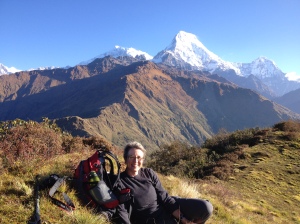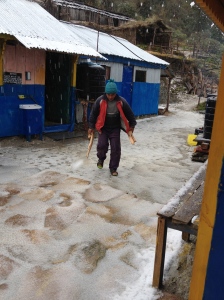Last week, trekking the Annapurna circuit with my nine-year-old son, Lucas, we hit a deserted, particularly tough patch of trail that had been partially swept away by a landslide. Single file, one foot in front of the other, five of us gingerly and slowly made our way across a six-inch-wide uneven slanted ledge, a sheer cliff up to our left and a sheer precipice to our right. The previous day’s rain had soaked the shale underfoot and it moved slightly with our weight. Our guide shouldered Lucas’ daypack and held his hand tightly instructing him not to look down the hill but just to focus on his feet. I struggled not to let my son see my intense fear of heights. Later, we both agreed it was just part of the incredible and inspiring week we had spent hiking.

Why do people come to Nepal to trek? The ever changing mountains take your breath away every moment of the day.©Lucas Zutt

In October, peak tourist season in Nepal, the main trails of the Annapurna Circuit are full of foreign trekkers. ©Donatella Lorch
This is not an unusual occurrence in Nepal, a land where mountains are steep and unstable, and weather patterns can transform a landscape in a split second. Everyday, newspapers print stories of roads wiped away by landslides, of villages marooned by snow falls or Monsoon-swollen raging rivers swallowing homes and fields. “In Nepal,” my friend Kunda Dixit warned me on this trek, “everything is further and more difficult than it seems.”
This week, at the height of the region’s trekking season, a perfect storm hit Nepal killing at least 24 foreign trekkers as well as seriously wounding Nepal’s tourism industry. Two days after cyclone Hudhud made landfall in Eastern India, it tore into Nepal. Lucas and I had just returned to Kathmandu when the storms started. In the Valley, torrential rain fell unabated for two days accompanied by ear-splitting thunder. Flights were cancelled or rerouted, almost all airports were closed.
The weather in the mountains was even more vicious and unpredictable especially in the Annapurna Conservation Area Project (ACAP), a favorite for trekkers who call it the Annapurna Circuit, an area that encompasses 7629sq kms. Blizzards and avalanches in Manang, near Thorong La Pass(5416m)and at Dhaulagiri Base Camp killed the trekkers most of them foreigners. But in this vast isolated area frequented by a huge number of tourists, it is unclear who is still missing.
One man slipped off a muddy path and fell into a river. He has not been found. We know about him because he was with many other trekkers. What about the more isolated areas of Manaslu and Langtang and the Tsum Valley? Even before Hudhud hit, the weather during our seven-day trek brought rain every afternoon turning into hail and snow at higher altitudes. Many of the smaller, narrower and desolate trails, like the ones we took, had landslides and were already water logged. We were four and had a guide as well as two porters (they moved way faster than we did) so we had safety in numbers as well as knowledge of the area. The only road to the northern part of the Annapurna Circuit takes you to Jomson. A good chunk of it is dirt and last month it was closed for a week because of rock fall. You can fly to Jomson, but only subject to the unbendable Nepali mountain rule: weather permitting. Even in good weather, flights cannot land in Jomson after 10am because of high winds. Fall and break a bone and you have two options: a helicopter or a multiple hour trip lugged in a stretcher to a road or an airstrip.

The flight Pokhara-Jomson offers stunning views and is very close to the mountain tops. ©Donatella Lorch
We met a group of three soloing young Americans from Colorado. They had no phones, an incorrect map (trekking map quality is poor in Nepal) and understandably a desire to get off the very beaten track and lose the hordes of other tourists. They had not registered at the US Embassy and their families did not know where they were going. Then there were the young Nepali tourists, climbing up the mountains in sneakers, without winter gear and most importantly not carrying any water. The Indian religious pilgrims that flock to the shrine in Muktinath near Thorong La Pass are also not prepared for winter. The women wear silk saris and thin shoes and ride up to the shrine on mules. And sometimes even if you are an expert mountaineer, the mountains can still claim you. Many years ago, Kunda’s brother, Kanak Dixit, had crossed the Thorong La Pass and was walking solo down past Manang when he slipped on the muddy trail and fell hundreds of feet down a cliff. He lay there badly injured for 48 hours before his brother found him. Kanak was helicoptered out and spent months in hospital. He still treks every year in all seasons.
It is a pristine Kathmandu afternoon today, a side-effect of a perfect storm. In front of me, the dark green of the valley’s hills melts into the emerald rice paddies, many flattened by the storm. My week in the high mountains taught me respect and made me fall in love. In the high mountains, I know the clouds and the evening cold will have already moved in. I hope the injured have been found.



